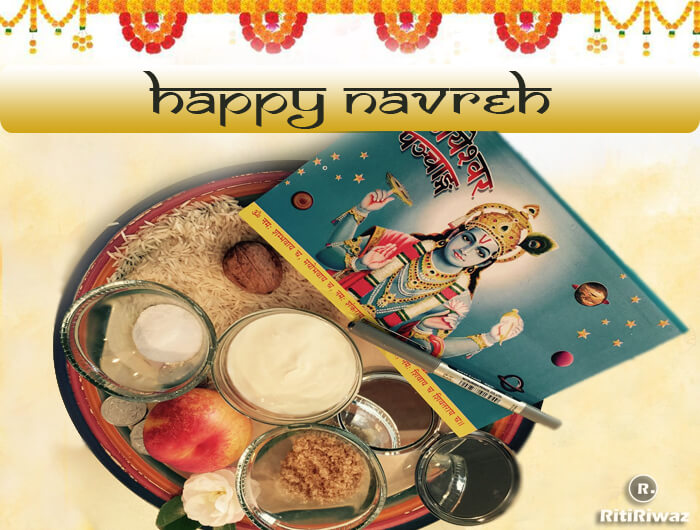Navreh 2025 – Kashmiri Hindu New Year

Navreh is the celebration of the first day of the Kashmiri New Year which falls on first day of Chaitra Shukla Pakhsh Pratipada (March/April). the day is celebrated across India with different names like Gudi Padwa is New Year for Maharastrian and Goan community, Cheti Chand is New Year for Sindhi community, Ugadi is Telugu and Kannada New Year, and Cheiraoba in Manipur.
In 2025 Navreh will be celebrated on 27th March. This coincides with the first day of the Chaitra (spring) Navratras. This day finds mention in Rajtarangini and Nilamat Purana of Kashmir. The people here celebrate this second Navratra (the first one is during the 9 days of the festival of Navratri, concluding with the Dusshera) in commemoration of the victory of their great King, Lalitaditya. Navreh falls on the same day as Gudhi Padwa or Ugadi.
Navreh Thaal

Navreh is derived from the Sanskrit word ‘Nava-Varsha’, meaning New Year. Kashmir Hindus observe a unique custom on this occasion. The evening before the day of Navreh, the housewife decorates a thali (a large silver or steel plate) and fills it with rice. She neatly arranges the new almanac (kreel pach), a local herb known as wye, dry or fresh flowers, sprouted grass, a small glass of water or milk, curds, honey, walnuts, pen, paper, a little salt, a small bread, some cooked rice, and a gold or silver coin on top of the rice.
These materials symbolize auspicious, wealth, prosperity and all good things to be desired in life. They are arranged aesthetically on the small mound of rice in the thali. The thal is prepared on the preceding night, then covered with a piece of cloth and kept overnight at the center of the house i.e. kitchen, chowk’e or may be the thokur kuth, prayer room right next to chowk’e.
The next day, well before daybreak, the oldest woman of the house, usually the grandmother or mother, goes around the house waking up family members one by one, asking them to open their eyes and first look at the plate, before beginning their daily chores. Known as Buth Vuchun, the ritual of looking at the plate is said to bring good luck, good health, prosperity and wisdom.
Each item on the plate has its own significance. While paddy symbolises wealth and expansion, cooked rice stands for progression in life and physical and mental growth. Curd stands for completeness, constancy and cohesiveness. The sweet roti represents engagement and amalgamation into one’s socio-cultural surroundings. The walnuts indicate the human and universal mind; the conjoined kernels represent the four purusharthas, goals of existence — dharma, discharge of duty; artha, acquirement of wealth; kama, gratification of desire, and moksha, liberation.
The coin stands for material strength and the gold ornament is the symbol of purity. While the medicinal herb indicates good health, flowers represent optimism, fragrance and sympathy in life. The pen is for wisdom and self-illumination and salt for positive energy. The almanac represents the influence of time in our life and the need to respect time and lead a disciplined life. Kreel Pach, the family goddess stands for trust in Her grace. The mirror, due to its attribute of reflection, stands for multiplication of auspiciousness.
Later in the day, rice from the plate is used to prepare the traditional yellow rice taher. Sumptuous dishes are prepared for visiting family and friends. The family celebrates the day preparing traditional dishes and other delicacies, wearing new clothes and entertaining their friends and relatives.
On the 3rd day of Navreh, the community members go out to nearby parks, temples, or outing spots to meet each other after four months of snowy -winter. It is a social gathering where men, women and children put on their best attire for the New Year chores. The eighth and the ninth days of the same fortnight are observed as Durga Ashtami and Ram Navami respectively.
